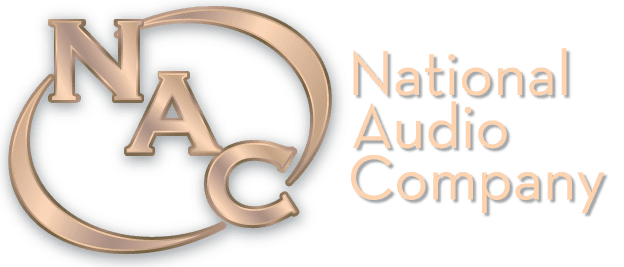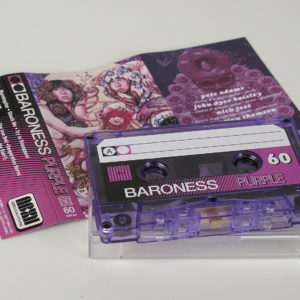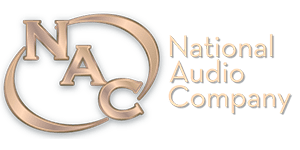Cassette Tape Duplication Services
Complete and submit a quote request.
See our new lower duplication prices.
National Audio Galleries
View our photo galleries of our people, process, customers and examples of final results.
Frequently Asked Questions
National Audio duplicates cassette tapes on high-speed, studio-quality, open-reel tape recorders known as duplicating slaves. This produces cassettes with a higher output level, lower background noise, less wow and flutter, and a 55-60 dB crosstalk rejection between tracks.
We do not duplicate from a master cassette. We create a master which is used to feed program material (sound) to as many as 20 slave duplicators. The duplication master also contains inaudible control tones and other automation data to operate our duplicating system.
Our engineers do not sonically alter your audio, unless requested. They simply ensure that output levels are uniform on the left and right channels and consistent on all tracks; maximizing the sound for the cassette format.
We add a small one-time charge for a duplication master to your first order. It is archived and re-used unless you request additional audio changes on subsequent re-orders.
National Audio doesn’t recommend that you have Dolby applied if your listeners may not all have Dolby capabilities on their playback devices. If you like the sound of your original master, you don’t need Dolby.
Dolby B for cassettes is intended to reduce tape noise on copied tapes, while leaving the original audio unchanged. It does not fix a sound master with unwanted noise. The original master is run through a Dolby encoder. The encoder basically boosts the upper frequencies while the audio is quiet, and doesn’t boost as much when the audio is loud (relative to a set threshold). The copied tapes are duplicated with this encoding of shifted frequencies. When played back on a deck with Dolby B engaged, the decoder reversed the boosts that were added to the original audio by the Dolby encoder according to the program levels that it senses. The result should be that the original audio sounds unchanged, but the tape noise (most noticeable in the higher frequencies) on the copied tapes has been reduced by almost 10 dB.
Keep in mind that not all players have Dolby encoders and later versions of the original Dolby B also exist. Many pros choose to duplicate their tapes without Dolby encoding for these reasons.
A Cassingle is a cassette tape packaged only in a paper sleeve called an O-Card, which is printed flat then glued on one side to create a box that’s open on both ends. The sleeve neatly slips around the cassette shell to protect it and provides space for art, titles and credits.
O-Cards (Cassingle sleeves) are often confused with Norelco box sleeves, which are constructed similarly, but at a larger size that slips around a plastic Norelco box containing a cassette. J-cards, U-cards and/or download cards may also be packed inside the Norelco box along with the cassette tape.
Tape inside cassette shells stores information when the recording device arranges tiny magnetic particles on the tape. It plays back when it moves over the electromagnetic head in a tape player and the movement causes a varying magnetic field that is interpreted as sound.
Powerful magnets can distort or erase recorded cassette tapes when they are in close proximity. Even a refrigerator magnet is powerful enough. Cassette tapes should always be stored away from magnets of all types.
The overall thickness of the tape itself dictates how much of it can fit inside a cassette shell. The plastic film substrate + the binder + the magnetic oxide surface = the tape thickness.
National Audio Company has only recently found the proper type of plastic substrate of a thickness to make (up to) 90 minute cassettes. Since NAC began manufacturing magnetic tape until now only a substrate to make 64 minute or shorter tape had been available. Any longer cassettes available anywhere (that we know of) have been made with older stock, not newly manufactured tape.
Analog audio recordings have two limits, a quiet noise floor where signals become inaudible and a loud upper ceiling where a system may create gross distortion and cause clipping. The space between the two extremes is the dynamic range.
Until the very last stage of mixing and mastering, an audio engineer attempts to keep levels at a “sweet spot” where there is plenty of margin for the range of the recording. The upper capacity of the system above the sweet spot is the headroom, and making the best use of it allows the reproduction of the audio to capture every nuance of the sound.
Though ideally largely unused, headroom refers to the space or buffer zone that accommodates the unexpected in order to create natural sounding highs, lows, and volume. National Audio’s Ferromaster C456™ tape provides greater headroom than other ferric tapes.
Two halves of a plastic cassette shell are normally joined in one of two ways, by screws or sonic welding. Sonic refers to a welding method often used for plastics. Ultrasonic welding creates a solid-state weld using high-frequency acoustic vibrations applied to plastics held together under pressure. No connectors, soldering materials or adhesives are required. Although shells screwed together can be repaired more easily, welded shells are popular because they are rigid, professional in appearance, and a bit more reliable than a shell joined together at a few selective points. Professional music releases are generally recorded on sonic shells.
The letter refers to the shape seen when you view the edge of the insert. Its folded shape looks like a J, an O, or a U. J-Cards and U-Cards may include extra panels folded inside.
A song played on the radio encompasses two separate copyrights, one for the musical composition and one for the sound recording.
The standard copyright symbol is © and applies to the author of a composition, the song and its lyrics. Copyrights generally apply to the life of the author (or last survivor of a team) plus 70 years, with some variations. This legal protection may also extend artwork and photographic materials used in the creation of packaging.
The symbol for copyrighted sound recordings is ℗. The p stands for phonogram, a legal term applied to the master recording of music, spoken words, or sounds on LPs, audiotapes, cassette tapes, compact discs, etc. A specific sound recording copyright does not apply to any other rendition or version, even if performed by the same artist(s). It is usually noted in the same way as the more familiar copyright symbol (example: ℗ 1987 Name of Owner). The author of the sound recording is typically the performer(s), the record producer, or both.
Answers to specific individual questions should be obtained from qualified legal counsel.
Ferric cassette tape is manufactured as thin plastic film coated with a magnetic layer of gamma ferric oxide (Fe2O3). Professional-grade tape is shipped on large pancakes (similar to reel to reel tapes) or wound into cassette shells as pre-recorded or blank tapes.
That depends. In most equipment the absence of tabs makes it impossible to record over the contents of the tape. National Audio always uses tabs-out shells for duplication orders to prevent the tape from being accidentally erased by the end-user.
If you record on cassette tapes yourself, tabs-in are easiest, but you can record on tabs-out cassettes by covering the holes with adhesive tape. Breaking out the tabs (or removing the tape) after recording prevents erasure.
Some professional recording equipment can record onto either tabs-in or tabs-out tapes.
Cassettes are recorded as side A and side B. Two stereo pairs of tracks (four total) are available on a cassette tape; the first stereo pair is played or recorded when the tape is moving in one direction and the other pair when moving in the opposite direction. So a standard 60 minute tape can contain up to 30 minutes of recorded material on each side.
Prepare your audio tracks so that side A and side B are approximately equal in length so there is not too much silence on either side.
90 minutes total recorded audio is the new maximum length that can be produced.
Imprinting is the process of printing your artwork, in a single ink color, directly on any of our color cassette shells. The imprint ink is permanently fixed on the shell using NAC’s commercial printing presses with UV dryers for a professional result.
Laser printed paper labels are also an option for colorful or complex designs. Labels can be multi-color and full bleed designs.
There are separate templates for imprints and for labels. Please use the correct one for your designs.
National Audio can work with almost any kind of media or digital audio file as the original for duplication. The most professional quality is achieved if you send .wav files that sound exactly as you like. The audio engineers at NAC make slight adjustments to make your recording sound its best on cassette tape. For more specific information click here.
Due to the volume of projects currently in house, our turn-around time for cassette duplication orders has extended to at least five weeks from the time we have received all the elements of your project: The three required forms, your audio master, and your album art files.
Rush orders are not available, but if you have deadline requirements call Customer Service to ask if your delivery date can be met.
Within a few days of the receipt of your project forms and files National Audio will email you a Sales Order / Invoice which can be paid with a major credit card using the link to our payment portal. You must pay the invoice before we begin work on your project.






